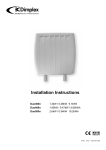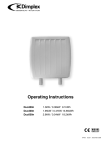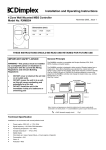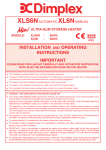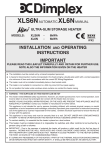Download Dimplex Duo400N Operating instructions
Transcript
Contact Details Please note that some of the contact details on this PDF document may not be current. Please use the following details if you need to contact us: Telephone: 0844 879 3588 Email: [email protected] The customer support section of our website also features a wide range of information which may be of use to you and is available 24 hours a day. It includes: • Operating and installation instructions • Easy ‘How to use’ guides for storage heaters • Service and repairs • Where to buy our products • Literature downloads • Heating requirement calculator Visit ‐ www.dimplex.co.uk/support A division of GDC Group Ltd Millbrook House Grange Drive Hedge End Southampton SO30 2DF www.dimplex.co.uk Registered No: 1313016 England VAT GB 287 1315 50004 EEE Producer Registration Number – WEE/GE0057TS Paper from sustainable sources Installation Instructions 85702 Dimplex DuoHeat Radiator Models: Duo300i, Duo400i and Duo500i Dimensions (including clearances diagram) Issue 12 Shelf or Overhang Curtains (millimetres) Specification Charge Acceptance 300i 1.3kW / 0.28kW 9.1kWh 400i 1.95kW / 0.34kW 13.65kWh 500i 2.6kW / 0.39kW 18.2kWh Model Height A Width B Depth C Duo300i 712mm 600mm 130mm+10mm Duo400i 712mm 830mm 130mm+10mm Duo500i 712mm 1060mm 130mm+10mm 250mm min. B 75mm min. Wall, Curtains or Furniture Models 75mm min. A C 150mm min. Furniture or other obstruction 110mm THESE INSTRUCTIONS SHOULD BE READ CAREFULLY AND RETAINED FOR FUTURE REFERENCE NOTE ALSO THE INFORMATION GIVEN ON THE APPLIANCE These instructions should not be left with the user, as this would invite the dismantling and servicing by unqualified persons. There is a separate instruction leaflet which should be left with the user explaining how the radiator should be operated. TO ENSURE THIS APPLIANCE IS OPERATING CORRECTLY, IT IS ESSENTIAL TO PERFORM THE CHECK PROCEDURE DETAILED ON THE BACK PAGE OF THIS INSTRUCTION. THIS MUST BE COMPLETED BEFORE NORMAL OPERATION COMMENCES. IMPORTANT SAFETY ADVICE WARNING - This radiator is VERY HEAVY. In order to maintain stability and to ensure its future safety in use, it is essential that the radiator is FIXED SOUNDLY TO A WALL and that the feet are mounted on a FIRM, LEVEL SURFACE. Care should be taken to avoid irregular surfaces, such as may result from tiled surrounds partially protruding under the radiator. It is important that the following instructions are strictly followed. WARNING – It is important that the fixing device chosen is appropriate to the wall material to which the radiator is being fixed. Some modern internal building materials are very low density block and require specialised fixing devices to provide a safe, secure installation. WARNING – This radiator must be installed where it is impossible for switches or other controls to be touched by a person using a bath or shower. WARNING – If during any reassembly of the radiator, a part of the thermal insulation shows damage or deterioration which may impair safety, it should be replaced with an identical part. WARNING – This radiator must not be located below a fixed socket outlet. Suggested Wall Fittings (see page 7 for further information) Solid brick/block: No. 10 Size plastic inserts (provided). 8mm drill bit. Drill 15mm deeper than plastic insert length. Plasterboard: If possible locate studding and use No. 10 woodscrews directly into the wood, otherwise M5 intersets. For other wall types seek specialist advice. WARNING - in order to avoid overheating, do not cover the radiator. DO NOT COVER OR OBSTRUCT the surfaces of the appliance. DO NOT POSITION under windows where curtains may contact the radiator (see minimum clearances above). DO NOT PLACE OBJECTS in contact with the radiator. -1- Electrical Connection WARNING – THIS APPLIANCE MUST BE EARTHED The installation of this appliance should be carried out by a competent electrician in accordance with I.E.E. Regulations for Electrical Equipment. The radiator is fitted with two flexible cables for connection to the fixed wiring of the premises through suitable connection boxes positioned adjacent to the radiator. Each supply circuit to the radiator must incorporate a double pole isolating switch having a contact separation of at least 3mm. This radiator is not suitable for connection to a 30A ring circuit. IMPORTANT The wires in the mains leads are coloured in accordance with the following code: GREEN & YELLOW: EARTH BLUE: NEUTRAL BROWN: LIVE BLACK (direct acting supply only): CONTROL WIRE Energy Retention Cells Energy retention cells are supplied separately to the radiator in packs of two. The reference number is 85743. Duo300i 8 Cells (4 Packs) Duo400i 12 Cells (6 Packs) Duo500i 16 Cells (8 Packs) -2- Circuit Diagram -3- INSTALLATION OF THE RADIATOR ASSEMBLY Turn the carton upside down and open the carton from the bottom. Remove the feet from the polystyrene corner supports and the accessories bag from the polystyrene centre support. 1 3 IMPORTANT BOTH FEET MUST BE SECURELY ATTACHED TO THE BOTTOM OF THE 1 RADIATOR BEFORE IT IS REMOVED FROM THE CARTON, AVOIDING DAMAGE TO THE THERMISTOR CLIP SHOWN IN FIG. 2. Fit the feet to the radiator by engaging the flanges on the top of the foot with the slots in the base of the radiator 1 . Push the foot towards the back of the radiator until it is fully engaged 2 . The radiator is packed with the direct acting mains cable clipped to the underside of the radiator ensuring it is secure during transit. The off peak mains cable will be secured with cable ties. Prior to installing the radiator, unclip the direct acting mains cable (do not remove or discard these clips). 4 2 NOTE: If the off peak mains connection is required to be made on the right hand side of the radiator, the pre-wired cable must be passed behind the feet and secured using the clips on the base of the radiator. For ease of access this should be done while the radiator is still upside down in the carton. Similarly when the direct acting mains cable is ready to be connected (See Section 23), if the connection is required to be made on the left hand side of the radiator the cable must be routed behind the feet. DO NOT clip the direct acting mains cable at this stage (See Section 23). The cable clips are already fitted at the factory to allow both mains cables to be attached, if required. 2 1 2 Thermistor Clip -4- Stand the radiator on its feet and remove packaging by sliding over the top of the radiator. Remove all additional internal protective packaging. Swing bottom of panel slightly away from the rest of the radiator (Fig. 7A) and lift upwards to unhook the top edge (Fig. 7B). 5 7 7A 5 Carefully disconnect the radiant element connector from the front panel (Fig. 7c). (See label on bottom of heater and graphic 7 D 7B 7C below). 7D Ensure the electronic components are not damaged when removing the panel. Carefully place the panel to one side. Check that the mains supply cables are not damaged. If they are to be replaced only heat resistant cable must be used (min T85) for the off peak cable and standard PVC 4 core mains cable (min T70) for the direct acting mains cable. Refer to sections 4, 21 and 22 for fitting the off peak and radiant element cables. 8 Stand the radiator on its feet and against a wall. Remove the securing screws along the bottom edge of the front panel. 6 6 Position radiator against wall in intended final position, ensuring it is on a firm base and taking note of the minimum fixing dimensions (see front page). 9 If the floor is carpeted it is important that the feet are The feet may rest on top of the carpet, however carpet gripper should be removed around the feet so that the radiator rests in a level position. 10 positioned firmly and securely. -5- WALL MOUNTING The following must be applied before fixing the 11 radiator to the wall: 11A NO SKIRTING BOARD / SKIRTING BOARD NO TALLER THAN 100MM 11A The radiator is to be mounted as shown in Fig. 11A, with the wall spacer bracket in its standard orientation. 11B Mark the position of the two mounting slots with the radiator pushed tight against the wall Fig. 11B. 11C Drill holes into the wall toward the bottom of the marked slots, as shown in Fig. 11C, following closely the guidelines opposite. 11B 11C Use the 10mm spacers provided (4 x 10mm) between the rear of the radiator and the wall. DO NOT use the 30mm spacers where there are no skirting boards or they are no taller than 100mm. DO NOT USE 30MM SPACER ON INSIDE OF RADIATOR. USE ONLY EXTERNALLY - SEE FIG. 12. 11D 11E 11F 11G 11D Place one 10mm spacer to the inside and another 10mm spacer to the outside of the location hole on the back panel Fig. 11D (see Fig 11A for wall spacer bracket orientation). 11E/F Carefully guide the radiator towards the drilled hole and screw part way to the wall Fig. 11E & 11F. NOTE: UNDER NO CIRCUMSTANCES SHOULD THESE SCREWS BE REMOVED WITHOUT FIRST REMOVING ALL ENERGY RETENTION CELLS FROM THE RADIATOR 11G Once both sides have been successfully positioned screw the radiator flush to the wall Fig. 11G. IMPORTANT: UNDER NO CIRCUMSTANCES SHOULD THESE SCREWS BE REMOVED WITHOUT FIRST REMOVING ALL ENERGY RETENTION CELLS FROM THE RADIATOR Do not fully tighten these screws until the core has been loaded into the radiator as some settling of the radiator may occur. -6- 12 SKIRTING BOARD TALLER THAN 100MM 12A Use the 10mm and 30mm spacers provided (2 x 10mm and 2 x 30mm) 12A 12B If the skirting board is taller than 100mm, the radiator is to be mounted as shown in fig 12A. Remove the wall mounting bracket and reassemble in the alternative orientation to give a greater spacing distance from the wall. 12B Place the 30mm spacer to the outside of the radiator and the 10mm to the inside Fig. 12B. Drill the holes as detailed in Section 11. Carefully guide the radiator towards the drilled hole. When in position screw part way to the wall to secure the radiator as in Section 11, remembering not to fully tighten the screws. Solid brick/High density block walls These must be drilled and plugged with the No. 10 size plastic inserts provided. The correct size of drill (8mm) should be used and the hole should be drilled to a depth of 15mm greater than the length of the plastic insert so that the fixing is made below the plaster layer. Low density block walls A special fixing, such as Unifix LB70 should be employed, following closely the manufacturers instructions. Panelled internal walls If possible, locate the studding and use No. 10 size woodscrews. Where it is not possible to locate the studding use type M5 Rawlplug INTERSETS on securely fastened plasterboard panelling. For other wall materials the wall panel manufacturer should be consulted for details of suitable wall fixing devices. -7- IMPORTANT: UNDER NO CIRCUMSTANCES SHOULD THESE SCREWS BE REMOVED WITHOUT FIRST REMOVING ALL ENERGY RETENTION CELLS FROM THE RADIATOR Remove the inner front panel by removing the screws along its top edge Fig. 13A. Carefully lift the bottom of the front inner panel out of the retaining flange at the base of the radiator, Fig 13B and remove the internal packaging, Fig. 13C taking care not to damage the insulation attached. 13 13A 13B 13c 14 Lift out the elements from the base insulation and rotate forwards. 14 DO NOT DISCONNECT THE TERMINALS -8- Carefully fit the bottom row of the back layer of energy retention cells, placing the two end cells in position first with the flat side toward the back. Fit the top row of cells also with the recess toward the element. 15 15A Refit the elements by carefully feeding the tails down through the hole in the base insulation, ensuring the tab is pointing forward. Fit the front layer of cells with the flat side toward the front of the radiator. Ensure that the tab on the element is captured below the bottom row of cells and that the element is vertical. 16 16A Replace the inner front complete with insulation by locating its bottom edge behind the front lip of the chassis and inserting the retaining screws along the top and both sides. 17 17 Check that the screws securing the radiator to the wall have been fully tightened. It is essential that all screws are replaced to ensure earth continuity. 18 Once installed DO NOT attempt to reposition the radiator without first unloading the energy retention cells and obtaining the services of a competent electrician. -9- 15B 16B 16C RADIANT ELEMENT OVERRIDE In its factory default setting, the radiant element will be allowed to operate for up to 2 hours after the beginning of the off peak charge period to maintain a comfortable room temperature if required. After 2 hours the radiant element will be automatically disabled until the end of the off peak charge period. In circumstances where it will not be necessary to maintain a high ambient room temperature between the hours of typically 12am and 2am (for example a commercial application) this feature can be disabled by removing the time delay pin on the power enable board (see Fig. 19B ), which will automatically switch the radiant element off at the beginning of the off peak charge period. 19 REASSEMBLY Reconnect the radiant 20 element connector as shown in Fig 20A. Replace the outer front panel by hooking onto the two location clips on the top panel Fig. 20B, 20C & 20D. Swing the bottom of the front panel gently towards the radiator Fig. 20E and carefully make sure any excess cable is fed through into the base of the radiator Fig. 20F. When securing the front panel with the screws provided, ensure the right hand corner is secured first to avoid trapping the cable. 19A 19B 20A 20C 20D 20B 20E If the direct acting mains supply connection is to be made on the left hand side of the radiator the pre-wired cable must be passed behind the feet and secured using the clips on the base of the radiator. Two sets of clips are already attached to the base of the radiator to allow the mains cables to travel parallel to each other, if required. See also Section 4. 20F Cut the mains cables to length. Ensuring the electricity supply is disconnected, connect the free end of the mains cable to a suitable double pole switch adjacent to the radiator – reinstate the electricity supply. Note – the double pole switch must have a contact separation of at least 3mm in all poles. 22 21 ON NO ACCOUNT SHOULD ANY SURPLUS CABLE BE PUSHED INSIDE OR BEHIND THE RADIATOR. CHECK ALL ELECTRICAL CONNECTIONS FOR TIGHTNESS. - 10 - ELECTRICAL CONNECTION 23 IMPORTANT REPLACING MAINS WIRE ON DIRECT ACTING SUPPLY CIRCUIT HEAT RESISTING CABLE MUST BE USED (MIN. T70) The wires in the direct acting supply cable are coloured in accordance with the following code: Follow the procedure to remove the outer front. Remove the PCB Bracket from the bottom of the outer front. Remove the wire from the connector block and earth screw. Using a pair of pliers remove the cable grip from the bracket. The replacement cable will be either 3 core or 4 core. 4 core is only required if a pilot wire is used to control the radiator from an outside source. For details of connection to Dimplex programming devices, please refer to the relevant Programmer Instructions. Note: Cable outside diameter to be between 5.9 - 7.4 mm GREEN & YELLOW: EARTH BLUE: NEUTRAL BROWN: LIVE BLACK: CONTROL WIRE The BLACK control wire is designed to carry a signal from a compatible remote programming device. If, however, a remote programmer is not being used, the appliance may be connected to the fixed wiring of the premises simply by cutting back the BLACK control wire, ensuring that it terminates within the outer insulating sheath of the supply cable. REPLACE CABLE AS FOLLOWS: Pass new mains cable through hole in side of PCB bracket connect wires as detailed opposite. Replace cable clamp ensuring any slack has been pulled back. There will not be sufficient room for excess cable when the PCB bracket is replaced onto the outer front. Do NOT connect the BLACK (PILOT) SIGNAL WIRE to earth. When the programmer drives other radiators, connect the pilot wires together in series. Any 240V insulated cable may be used to link pilot wires around the ring main. A low signal current is used. Suitable connections would be either an additional single core wire marked or colour coded appropriately or use a 4 core cable throughout the radiator ring. As a mains conductor, the pilot wire should be isolated in accordance with the IEE regulations. Cleaning WARNING – ALWAYS DISCONNECT FROM THE POWER SUPPLY BEFORE CLEANING THE RADIATOR. Do not use detergents, abrasive cleaning powder or polish of any kind on the body of the radiator. For further details of connection to Dimplex programming devices, please refer to the relevant Dimplex programmer instructions. Allow the radiator to cool, then wipe with a dry cloth to remove dust and a damp cloth (not wet) to clean off stains. Be careful not to allow moisture into the radiator. After Sales Service Your Radiator is guaranteed for two years from the date of purchase. We undertake to repair or exchange free of charge within this period, any part found to be defective due to a manufacturing fault. Your rights under this guarantee are additional to your statutory rights, which in turn are not affected by this guarantee. Please retain receipt as proof of purchase. - 11 - CHECK PROCEDURE FOR INSTALLERS FOLLOWING INSTALLATION THIS CHECK PROCEDURE SHOULD BE CARRIED OUR BY A COMPETENT INSTALLER ONLY. A QUICK START GUIDE AND OPERATING INSTRUCTIONS ARE AVAILABLE FOR END USERS. DuoHeat has two heat output modes Comfort (Radiant Heat) and Background (Retained Heat) . Under normal operation the temperature control display will always operate the radiant panel, (Comfort). Note:- Front Panel should be fully installed onto radiator and only Peak supply is switched on, with red bar(s) showing on the temperature control display, before starting the check procedure. 1. (i) Adjust the “off peak” control setting (Background heat) to position no. 10 as follows; press and hold button on the temperature control down the display until 10 red bars are illuminated, continue to hold the button for a further 7 seconds and a single red bar will flash. Use the button to move the flashing red bar to the right hand side i.e. the No. 10 position (shown below). + + + 2. heat). To check the radiant panel operation (comfort (i) Adjust the temperature control display as follows; button until 10 red bars are press down the illuminated (shown below). After 2 minutes the front panel should now feel warm, this will confirm correct operation. + (ii) If the front panel does not heat up and room temperature is below 25°C, remove front panel and ensure there is no damage to front panel or radiant element and that all electrical connections are secure. If front panel is still not heating up, phone customer help line. NOTE: After 20 seconds the temperature control display will return to the Comfort control mode. (ii) Ensure “Off Peak” supply is in the Off position. Unscrew the spur from the wall. Check the continuity on the storage side of the spur.. If the circuit is closed this will confirm that the “off peak” storage circuit (background heat) is operational. (iii) If the “off peak” circuit shows open circuit and room temperature is below 25°C, switch off the “peak” front panel electricity supply and check if the circuit has closed. If off peak circuit is still open, check all electrical connections are secure, only then phone customer help line. If room temperature is above 25°C, radiator will not operate. IMPORTANT Once radiator has been confirmed as fully operational, use the “Quick Start Guide” to set up initial customer settings. Please ensure the “Quick Start Guide” and the “Operating Instructions” are left with the radiator for user information. Reconnect spur and switch on radiator. This appliance complies with the European Standards EN60335-2-30, EN 60 335-1, EN 60 335-2-61, EN 61000-3-2, EN 61000-3-3, EN 55014 and EN55104 for Safety & Electromagnetic Compatibility. These standards cover the requirement of the EMC Directives 89/336 & 73/23 Dimplex UK Limited Millbrook House Grange Drive Hedge End Southampton Hampshire SO30 2DF © Dimplex UK Limited Customer Help Line 0845 600 5111 Mon–Thurs 08.30-17.00 and Fri 08.30-16.00 (Sept-April) Mon–Thurs 08.30-17.00 and Fri 08.30-15.00 (May to August) Fax 01489 773 050 Web-site www.dimplex.co.uk e-mail [email protected] Republic of Ireland 01 842 4833 - 12 or- part, without prior permission in writing from Dimplex UK Limited. All rights reserved. Material contained in this publication may not be reproduced in whole













